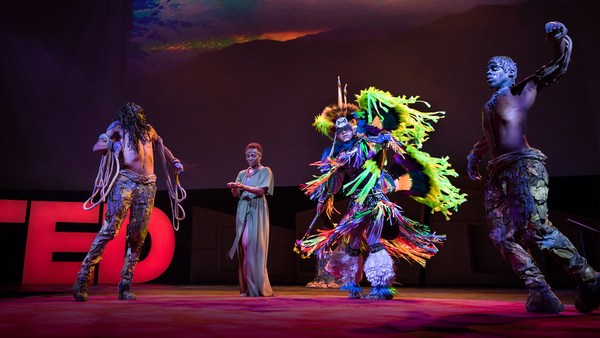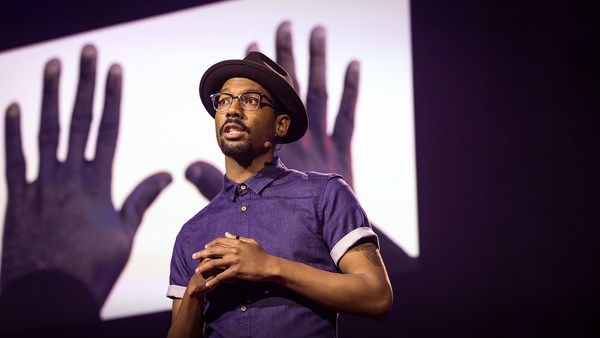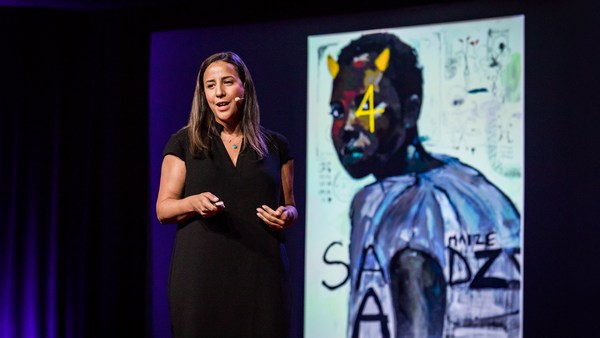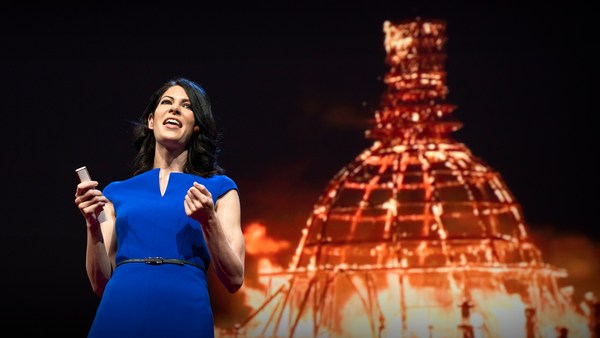[Yoruba: Freeborn Ijebu-Ode son,] [of true Ogbogbo Clan,] [whose wealth and resources surpass all that Europe ever had,] [whose altar is filled with gold.]
This chant is called the oríkì. My grandmother used to sing it to me when I was a child in Nigeria. See, an oríkì is the song of praise of the Yoruba people, and this particularly speaks of treasures that the West does not have.
Mama -- that's what I call my grandmother -- told me many stories about Yoruba mythology. You see, the Yorubas are an ethnic group from the southwestern part of Nigeria, and I was always fascinated by these stories. I was always intrigued. And Yoruba culture has inspired my art since I was a child. You see, African art is not just what you buy at Harlem markets in New York. Every artist has a name, and every artist has a story. This is my story.
See, mama had tattoos on her arms and her legs. As a child, I thought she was born with them, with beautiful black lines and detailed symbols. And then she told me that they were actually symbols from the Yoruba mythology. I never knew how this was going to influence the artist that I am today. You see, as a young child, I saw art everywhere. I remember the house we lived in in Ilorin, in Stadium Road. We had marble floors, and you know, I would look at the marble floors, and I would see all sorts of patterns and designs in it, and I thought everybody could see them. So I would call my brother, and I would be like, "Ikeolu, come and see this marble design, see this pattern, see this mask." And he would tell me, "Laolu, I don't see anything." So I would use ink, and I would trace out what I saw on the floor. And then when my mom noticed, she got really upset.
(Laughter)
But that didn't stop me. I switched from ink to chalk, because I got in trouble a lot with my teachers and my parents. So I remember my mom said, "Laolu, we are Christians. Why don't you draw like other people? Why don't you draw landscapes or maybe you draw chairs or furniture, or maybe even draw Jesus?"
You know, I could paint the whole house if I had a chance, but when I grew up, I knew being an artist was not an option, so I wanted to be the person my parents wanted me to be, so I went to law school. Of course, that's my dad there. He was so proud that day. And this was what my notebooks looked like in law school.
(Laughter)
Of course I would miss classes, and I would make up excuses why I wasn't going to class.
But when I started working at the Human Rights Commission as a human rights attorney, my mind was elsewhere. I saw a very tough reality. I worked with children who had to choose between getting an education and actually being forced into marriage. I was so frustrated seeing all the injustice around me, and my only outlet was art, so I started painting.
This piece is called "Dreamscape." So when you zoom into this piece, you're going to see a girl child and the accidental birth, the fact that our future is controlled by where we are born. Now, the next one you see a man and a man holding hands, a woman and a woman holding hands. You see, in Nigeria, same-sex relationship is criminalized. You can actually get 14 years for that.
With my art, I like to tell stories. Through my art, I like to start a conversation. So in this one, you see the map of Africa, you see the questions, you see crying, and there you see syringes plugged into Africa and the natural resources being drained out. So I asked myself, where does it go? Who benefits from all of this? You see, with my art, the way I weave my art around the patterns, the masks, the stories, and the way I use my lines, it's all from the Yoruba culture.
So in 2013, I made a big gamble. I quit my job and I moved to New York City to practice art full time. Of course, my parents were like, "Oh, [it's just a phase.] He'll come back." But life as an artist in New York was not easy, because I was broke, no money, no gallery agents, no representation, so no gallery would show my work. So I thought to myself, I need to survive. So I started painting on clothes to make a living. I started painting on shoes. I started customizing things for people. And then soon I realized the power, because people were so proud to wear their stories. So I started painting on everything. I painted on guitars, I started doing murals, anything I could find my hand on I painted, and everything became my canvas.
So one day, I was just going on my Instagram feed, and I saw this picture. It was Reign. She took a picture standing in front my art, and the moment I saw that photo, something happened in that moment. I could actually see my artwork go into her and come out of her literally, and that's how I started painting on human bodies. As a child I saw art on the marble floors, I saw art on walls, but now I see art on people's faces and people's bodies. I remember my grandmother, and I realized that most of my creative instincts were actually based on my childhood memories and the art on my grandmother's skin.
Now I look at all the people I painted, and I think to myself, like, what would it look like if we all walked around like gods and goddesses from Yoruba mythology? And boom, that's how The Sacred Art of the Ori was born. You see, Ori in Yoruba mythology means your soul, it means your essence, it means your instincts. And I realized that only when you tap into your Ori, then you can actually move mountains. So there's something so immediate about painting on human bodies. It's like art in motion. It's like a 3D experience.
So one day, I was just doing my regular work in Brooklyn, and I got an email that said, "Hi, I'm a big fan of your work. Would you like to paint for my music video? Signed, Beyoncé." Like, Beyoncé emailed me. I was like, what?
(Laughter)
I was like, what, how did she even know me? I thought this can't be true. Of course I thought it was a scam. The Nigerian in me was like, nah.
(Laughter)
(Applause)
But incredibly enough, it was real, it was true, and things happened really fast. You see, Beyoncé wanted to pay homage to New Orleans, and my art reminded her of her creole origins. So when "Lemonade" dropped, of course, boom, everything just went from zero to 100 real fast. People featured me in magazines, interviews. People stopped me in the street. People knew my name, like -- And sometimes I had to step back and just chill, and, like, take everything in. You know, as artists, we work so hard all our lives for our art to be recognized, and for this I feel blessed. However, the attorney in me is still there, so I use my art to fight for what I believe in. My Yoruba heritage is always there.
I'd like to share with you tonight some of my art in motion. Please, welcome with me on stage.
(Music)
(Applause)
Now, this is Geli, and this is Reign. These are the first two people I ever painted in my life, and I spent the past day painting on them. Tonight, they represent my hopes and my fears. Now, I put my fears on the back. I put my hopes in front. What are my hopes? I hope that people know that Africa is not just one huge, nameless continent that is all the same. I also hope that people know that in Nigeria, we have over 350 ethnic groups and languages, and I am just one artist from one of them.
(Applause)
I also hope that you know that I hope I will be able to change the way people talk about African art on the continent and here, and I hope you know that African art is not just what you buy at Harlem markets in New York and that every piece of art you see has a story, and every artist has a name.
Thank you very much.
(Applause)





